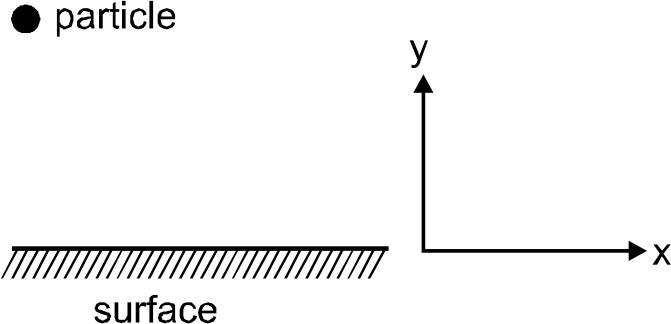A particle of mass m with an initial velocity uˆi collides perfectly elastically with a mass 3 m at rest . It moves with a velocity vˆj after collision , then , v is given by :
v=√23u
v=1√6u
v=u√3
v=u√2
To solve the problem, we will use the principles of conservation of momentum and conservation of kinetic energy, as the collision is perfectly elastic.
1. Identify Initial Conditions:
- Mass of the first particle, m1=m (moving with initial velocity →u=u^i).
- Mass of the second particle, m2=3m (initially at rest, so its velocity is 0).
- After the collision, the first particle moves with velocity →v=v^j.
2. Conservation of Momentum in the x-direction:
- Initial momentum in the x-direction:
pinitial,x=m⋅u+3m⋅0=mu
- Final momentum in the x-direction:
pfinal,x=m⋅vx+3m⋅0=mvx
- Setting initial momentum equal to final momentum:
mu=mvx⟹vx=u3
3. Conservation of Momentum in the y-direction:
- Initial momentum in the y-direction:
pinitial,y=0
- Final momentum in the y-direction:
pfinal,y=m⋅v+3m⋅vy
- Setting initial momentum equal to final momentum:
0=mv+3m⋅vy⟹vy=−v3
4. Conservation of Kinetic Energy:
- Initial kinetic energy:
KEinitial=12mu2
- Final kinetic energy:
KEfinal=12mv2+12(3m)((u3)2+(−v3)2)
- Simplifying the final kinetic energy:
KEfinal=12mv2+12m(u23+v23)=12mv2+m6(u2+v2)
- Setting initial kinetic energy equal to final kinetic energy:
12mu2=12mv2+m6(u2+v2)
5. Solving for v:
- Cancel 12m from both sides:
u2=v2+13(u2+v2)
- Rearranging gives:
u2=v2+u23+v23
- Multiply through by 3 to eliminate the fraction:
3u2=3v2+u2+v2
- Simplifying:
2u2=4v2⟹v2=u22
- Taking the square root:
v=u√2
Final Answer:
v=u√2
- Mass of the first particle, m1=m (moving with initial velocity →u=u^i).
- Mass of the second particle, m2=3m (initially at rest, so its velocity is 0).
- After the collision, the first particle moves with velocity →v=v^j.
- Initial momentum in the x-direction:
pinitial,x=m⋅u+3m⋅0=mu
- Final momentum in the x-direction:
pfinal,x=m⋅vx+3m⋅0=mvx
- Setting initial momentum equal to final momentum:
mu=mvx⟹vx=u3
- Initial momentum in the y-direction:
pinitial,y=0
- Final momentum in the y-direction:
pfinal,y=m⋅v+3m⋅vy
- Setting initial momentum equal to final momentum:
0=mv+3m⋅vy⟹vy=−v3
- Initial kinetic energy:
KEinitial=12mu2
- Final kinetic energy:
KEfinal=12mv2+12(3m)((u3)2+(−v3)2)
- Simplifying the final kinetic energy:
KEfinal=12mv2+12m(u23+v23)=12mv2+m6(u2+v2)
- Setting initial kinetic energy equal to final kinetic energy:
12mu2=12mv2+m6(u2+v2)
- Cancel 12m from both sides:
u2=v2+13(u2+v2)
- Rearranging gives:
u2=v2+u23+v23
- Multiply through by 3 to eliminate the fraction:
3u2=3v2+u2+v2
- Simplifying:
2u2=4v2⟹v2=u22
- Taking the square root:
v=u√2
v=u√2
Topper's Solved these Questions
Similar Questions
A particle of mass m moving with speed u collides perfectly inelastically with another particle of mass 3 m at rest. Loss of KE of system in the collision is
View SolutionA particle of mass m with an initial velocity uˆi+2uˆj collides with a particle of mass 3m at rest. After collision, the two particles stick together and the combined particle moves with a velocity vˆi+v'ˆj. Which of the following is incorrect?
View SolutionA particle of mass m moving with speed u collides perfectly inelastically with another particle of mass 2m at rest. Find loss of kinetic energy of system in the collision.
View SolutionA particle of mass m moving with speed u collides perfectly inelastically with another particle of mass 2m at rest. Find loss of kinetic energy of system in the collision.
View SolutionA particle of mass m1=4kg moving at 6ˆims−1 collides perfectly elastically with a particle of mass m2=2 moving at 3ˆims−1
View SolutionA ball of mass m moving with velocity v collides head on elastically with another identical ball moving with velocity - V. After collision
View SolutionTwo particles of same mass m moving with velocities u1 and u2 collide perfectly inelastically. The loss of energy would be :
View SolutionA body of mass m moving with velocity uˆi collides elastically with a body at rest of mass 3m and then the final velocity of body mass m is v ˆj. Find the relation between v and u
View SolutionTwo particles of masses m and 2m moving in opposite directions collide elastically with velocity 2v and v, respectiely. Find their velocities after collision.

View SolutionA particle moving with velocity (2ˆi−3ˆj) m/s collides with a surface at rest in xz–plane as shown in figure and moves with velocity (2ˆi+2ˆj) m/s after collision. Then coefficient of restitution is :

View Solution
